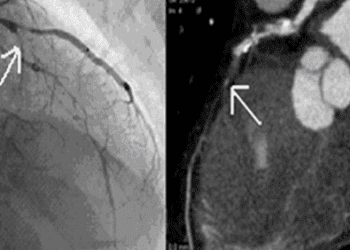Treat-to-target approach non-inferior to high-dose statin therapy in patients with coronary artery disease
1. Patients who received statin therapy using a treat-to-target approach (targeting LDL-cholesterol of 50-70mg/dL) did not have worse cardiovascular outcomes than those receiving high-dose therapy at a 3-year endpoint.
2. In both groups, approximately 8% of subjects experienced the primary composite endpoint (3-year mortality, myocardial infarction, stroke, coronary revascularization).
Level of Evidence Rating: 1 (Excellent)
Study Rundown: Statin drugs are essential therapeutic measures in managing coronary artery disease to prevent adverse cardiovascular events, including myocardial infarction and stroke. Statins are HMG-co-reductase inhibitors and lower low-density lipoprotein (LDL) cholesterol levels. However, previous studies have provided mixed conclusions regarding the optimal dosing for statin drugs: potential strategies include the prescription of high-dose statins versus titrating doses to achieve a target LDL-cholesterol serum concentration. The Low-Density Lipoprotein Cholesterol-Targeting Statin TherapyVersus Intensity-Based Statin Therapy (LODESTAR) trial sought to determine which approach to statin therapy is preferred in patients with coronary artery disease.
4400 patients were randomized between 2016 and 2019, with 2200 patients in each control and intervention group; 98.7% of patients completed all follow-up study visits. At baseline, 25% of patients were already taking a low/moderate dose statin, and 57% were taking a high dose. 73% of patients in the intervention group remained on their original statin dose throughout the study period. LDL-C levels were higher in the intervention group than the control group only for the first 6 weeks of the study; at every timepoint thereafter, there was no significant difference in cholesterol. Significantly more patients in the target-to-treat group achieved an LDL-C below 70 mg/dL than in the control group. 8.1% of patients in the intervention group and 8.7% in the control group experienced the primary composite outcome of cardiovascular morbidity or mortality within three years – this was not significantly different between the two groups.
The present study by Hong et al. demonstrated that a target-to-treat approach is non-inferior to high-dose statin therapy in reducing adverse cardiovascular outcomes in a population with known coronary artery disease over three years. This work suggests that an individualized approach to statin prescribing with a potential LDL-C target below 70mg/dL may be effective. A strength of this work includes the large sample size and long follow-up period. One limitation of this study is that only patients with coronary artery disease were included. Therefore, these results cannot be generalized to all statin users, including those who are prescribed cholesterol-lowering medications for primary prevention alone.
Click here to read this study in JAMA
Relevant reading: The safety and tolerability of statin therapy in primary prevention in older adults: a systematic review and meta-analysis
In-Depth [randomized controlled trial]: A multicenter, noninferiority, randomized controlled trial was performed in South Korea. Eligible patients were adults with clinically-diagnosed coronary artery disease (stable ischemia, acute coronary syndrome). Patients were randomized 1:1 to receive either treat-to-target statin therapy (intervention group) or high-dose statin therapy (control group). Patients were further randomized to receive either atorvastatin or rosuvastatin within the intervention and control groups; at both levels, randomization was stratified by baseline LDL-C level, history of acute coronary syndrome and presence of diabetes. The control group received either 40 mg of atorvastatin daily or 20 mg of rosuvastatin daily; the intervention group received a starting dose of 20 mg atorvastatin or 10 mg rosuvastatin daily which was tailored to a target LDL-C below 70 mg/dL. Patient data were collected at baseline, 6 weeks, then at 3, 6, 12, 24 and 36 months. At three years, the primary endpoint was a composite of mortality, myocardial infarction, stroke, and coronary revascularization.
In the treat-to-target study group, 17% of patients required up-titration and 9% required down-titration, whereas 73% maintained the baseline statin dose. Co-treatment of high cholesterol with ezetimibe was used more frequently in the intervention group in addition to high-dose statin therapy to achieve the LDL-C target. The mean (standard deviation) LDL-C level was significantly higher in the intervention than in the high-intensity statin therapy group (69.6 [21.2] mg/dL vs 66.8 [21.8] mg/dL; difference, 2.8 mg/dL [95% CI, 1.3 to 4.3]; P < .001) at 6 weeks. After 6 weeks, the LDL-C levels did not differ between the groups.
8.1% of patients in the intervention group and 8.7% in the control group experienced the primary composite outcome of cardiovascular morbidity or mortality within three years (absolute difference -0.6%, p<0.001 for noninferiority). All-cause mortality occurred in 2.5% of patients in the intervention group and 2.5% in the control group.
Image: PD
©2023 2 Minute Medicine, Inc. All rights reserved. No works may be reproduced without expressed written consent from 2 Minute Medicine, Inc. Inquire about licensing here. No article should be construed as medical advice and is not intended as such by the authors or by 2 Minute Medicine, Inc.







